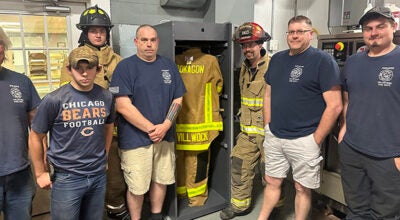Michigan Works! ‘swamped,’ sees ‘uptick in hiring’
Published 6:27 pm Sunday, March 6, 2011
CASSOPOLIS — Cass County job-seeking traffic tracked at the Dowagiac service center last year totaled 3,585 unique visitors, 18,395 visits and a daily average of 70.
“We were swamped,” Michigan Works! Executive Director Todd Gustafson advised the Board of Commissioners Thursday night. “The labor force in Cass County is 25,285, with 22,447 employed and 2,838 unemployed.”
There are 1,878 businesses in Cass County.
Michigan Works! is one of 25 such agencies in the state.
“We’re all fruit,” Gustafson said, “but some are apples and some are oranges. Some are part of county government, some are part of cities, some stand alone. We’re one of the handful of three that are non-profit organizations” serving employers. “which actually puts us in a better position to secure additional revenue beyond state and federal resources. We’ve been really aggressive in attracting monies to better serve our three counties,” Cass, Berrien and Van Buren.
“As of today,” he said, “we have 81 different funding sources. Our mission is to provide a skilled workforce. Right now we work with about 5,000 employers across the tri-county region. There are actually 20,000 employers, so that number needs to increase. We roughly serve about 20,000 jobseekers annually.”
Michigan Works! also has offices in South Haven and Paw Paw, Bertrand Crossing in Niles, Buchanan and Benton Harbor, which also has an at-risk academy.
Unemployment has gone from 3.4 percent in December 2000 to 14.6 percent in December 2009 and 11.2 percent in December 2010, when it surpassed state and national averages.
“The good news is the unemployment rate is declining,” Gustafson said. “Yet, we’re still very high. It’s a combination of both” people landing jobs and falling off the jobless rolls, he told Chairwoman Minnie Warren, D-Pokagon Township.
“We do see an uptick in hiring,” Gustafson said, “and the economy is at least stabilizing. There are a number in manufacturing, health care and hospitality that are starting to hire back, but there are a significant number of people who have fallen off the rolls because they’ve given up looking for jobs or have moved.”
A main service Michigan Works! provides is helping retrain laid-off workers and rapid response if companies close.
“If a company, no matter what industry, is laying off individuals,” he said, “by law they are required to notify us. That triggers a series of events including us going to that company and working with those folks who are about to be laid off,” Gustafson said, including in 2010 Whirlpool, Alcoa, Bosch, National-Standard and Modineer.
“The good news,” he added, “is that a large number of the 5,000 companies we work with have been hiring — one, two, 10, you name it. In 2009 alone, when the recession hit and many jobs were shed, there were still, that we are aware of, thousands of jobs filled from the churn.”
Gustafson said one challenge is that many employees who lose their jobs logged 20 to 30 years right out of high school at one company and their skills are seldom transferrable to other employment, so “we’ve invested millions of dollars into getting people trained” at both community colleges, Southwestern and Lake Michigan.
Gustafson said, “As the regional workforce agency, we’ve determined the high-growth, in-demand industries for southwest Michigan are — and they’re not a big surprise — health care, hospitality, energy with two nuclear plants and advanced manufacturing.
“Many of you have heard of the decline of manufacturing. Although it’s changed substantially, manufacturing is still alive and well and there will be manufacturing companies. The difference is they need a higher skill set from employees they hire. Many advanced skills require going back to school.”
Since 2007, 1,800 people have received some sort of training, representing a “significant financial investment.”
In Cass County, 140 adults have been served with basic education.
“Is that enough? No,” Gustafson said. “There are a significant number of adults who require remediation before we can get them into training. Some need help even turning on a computer.”
Michigan Works! has a summer youth jobs program which served 138 Cass County youth since 2007.
Gustafson said, “The big $60,000 question today is about 30 percent of our money comes from the Workforce Investment Act, which was zeroed out in the budget the House recently passed for 2011-2012.
That would put a serious dent in our ability to provide services.
“The Senate has said it recognizes the need for these services, so my expectation is they’ll meet in the middle, although I’m not sure where that is. At the very minimum, in all likelihood we could end up back at 2008 levels — a 20-percent cut. That gives the workforce board serious pause in how we move forward.
At the state level, with Gov. Snyder’s focus on reinventing government, shared services and consolidation, that’s another issue on our radar. What other regions can we look at proactively? Do we need 25 or less? We’re doing our homework.”
Commissioners’ liaisons to the workforce development agency are Bob Wagel, R-Wayne Township, and Roseann Marchetti, R-Edwardsburg.
Warren is involved with the prisoner re-entry program, hiring former offenders to work at her Niles factory as they return to the community.






